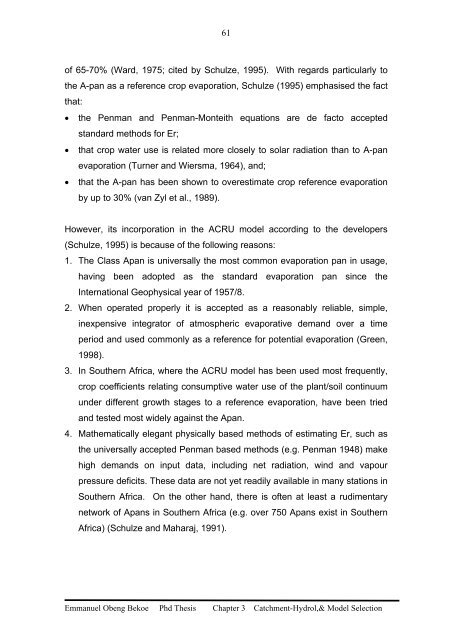PhD Thesis Emmanuel Obeng Bekoe - Cranfield University
PhD Thesis Emmanuel Obeng Bekoe - Cranfield University
PhD Thesis Emmanuel Obeng Bekoe - Cranfield University
Create successful ePaper yourself
Turn your PDF publications into a flip-book with our unique Google optimized e-Paper software.
61<br />
of 65-70% (Ward, 1975; cited by Schulze, 1995). With regards particularly to<br />
the A-pan as a reference crop evaporation, Schulze (1995) emphasised the fact<br />
that:<br />
• the Penman and Penman-Monteith equations are de facto accepted<br />
standard methods for Er;<br />
• that crop water use is related more closely to solar radiation than to A-pan<br />
evaporation (Turner and Wiersma, 1964), and;<br />
• that the A-pan has been shown to overestimate crop reference evaporation<br />
by up to 30% (van Zyl et al., 1989).<br />
However, its incorporation in the ACRU model according to the developers<br />
(Schulze, 1995) is because of the following reasons:<br />
1. The Class Apan is universally the most common evaporation pan in usage,<br />
having been adopted as the standard evaporation pan since the<br />
International Geophysical year of 1957/8.<br />
2. When operated properly it is accepted as a reasonably reliable, simple,<br />
inexpensive integrator of atmospheric evaporative demand over a time<br />
period and used commonly as a reference for potential evaporation (Green,<br />
1998).<br />
3. In Southern Africa, where the ACRU model has been used most frequently,<br />
crop coefficients relating consumptive water use of the plant/soil continuum<br />
under different growth stages to a reference evaporation, have been tried<br />
and tested most widely against the Apan.<br />
4. Mathematically elegant physically based methods of estimating Er, such as<br />
the universally accepted Penman based methods (e.g. Penman 1948) make<br />
high demands on input data, including net radiation, wind and vapour<br />
pressure deficits. These data are not yet readily available in many stations in<br />
Southern Africa. On the other hand, there is often at least a rudimentary<br />
network of Apans in Southern Africa (e.g. over 750 Apans exist in Southern<br />
Africa) (Schulze and Maharaj, 1991).<br />
<strong>Emmanuel</strong> <strong>Obeng</strong> <strong>Bekoe</strong> Phd <strong>Thesis</strong> Chapter 3 Catchment-Hydrol,& Model Selection

















